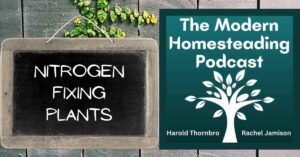On This Episode of The Modern Homesteading Podcast, Harold and Rachel Talk About Useful Perennials You Can Grow On Your Homestead That Multiply Through Division To Expand Your Garden.
The Modern Homesteading Podcast, Episode 196 – April 11, 2023
Listen To The Podcast
Listen and Subscribe On Your Favorite Podcast Player
Spotify | Apple Podcasts | Amazon Music | Pandora | Pocket Casts | Castbox | Anchor | YouTube | RSS
Modern Homesteading Members Listen Ad-Free on Spreaker
A Few Useful Perennials You Can Multiply Through Division
What are Crowns
Crowns are the part of a plant that lies beneath the soil surface and serves as the point from which new shoots emerge. Dividing a crown can be done using various tools such as a garden fork, sharp spade, knife, or by hand, depending on the size of the plant.
For plants that experience a period of dormancy, it’s best to divide them just before regrowth. In contrast, for plants that have leaves all year round, dividing them in early spring is ideal. However, it’s essential to cut back the leaves by two-thirds to prevent water loss and wilting during the development of new shoots.
What are Bulbs
Bulbs, like lilies, can be reproduced from fleshy leaf scales, with new bulbs sprouting from the parent bulb. When the bulbs are dormant, they can be separated from the parent bulb and planted separately. These new bulbs are referred to as bulblets or sometimes offsets.
What are Corms
Corms are often mistaken for bulbs due to their similar appearance. Unlike bulbs, corms lack modified leaves like the onion and are instead compressed stems. They cannot be separated into individual leaf scales.
Cormlets can be carefully separated from the parent corm and grown to produce new plants. If the cormlets are small, they should be grown in a container until they reach a suitable size for transplanting into a garden. It generally takes one or two years for a plant to reach flowering size.
What are Tubers
Tubers are categorized into two types: stem tubers and root tubers.
A stem tuber is an enlarged underground stem that can produce shoots from buds, also known as ‘eyes’. They can be divided either by cutting them into pieces or grown from a small tuber known as a ‘seed’ tuber.
A root tuber, on the other hand, is a swollen root that can be divided in spring, with each piece requiring a piece of the tuber that contains a bud.
What Are Runners and Stolons
Runners refer to the horizontal stems that emerge from a crown and are found below the ground. In contrast, stolons are located above ground level. Nodes along the runner produce both roots and shoots, and the newly formed plantlets at these nodes can be separated from the runner and transplanted. For optimal growth, it is recommended to transplant the plantlets into moist, fertile soil that is easy to crumble.
What Are Rhizomes
Rhizomes refer to the stems that grow beneath the soil surface, which can be divided by cutting the parent plant into sections during its dormant phase. Each section must contain a bud at a node, from which new shoots and roots will emerge.
Perennials of These Types You Can Add To Your Homestead
Russian Comfrey
- Growing Zones 3-9
- Crown (Clump)
- Benefits
Daylilies
- Growing Zones 2-11
- Tubers
- Benefits
- Edible
- Attracts Pollinators
- Hardy
Goldenrod
- Growing Zones 2-8
- Bulbs(Clump) and Rhizomes
- Benefits
- Medicinal
- Attracts Pollinators
- Culinary – edible flowers, teas
- Cosmetics
Yarrow
- Growing Zones 3-9
- Crown (Clump)
- Benefits
- Dynamic Accumulator
- Attracts Pollinators and Other Beneficial Insects
- Medicinal
Lamb’s Ear
- Growing Zones 4-9
- Crown (Clump)
- Benefits
- Groundcover
- Medicinal
- Traditionally used as toilet paper
Catmint
- Growing Zones 3-8
- Crown (Clump)
- Benefits
- Tolerant
- Edible
- Attracts Some Pollinators
- Deters Some Harmful Pests
Bee Balm
- Growing Zones 3-9
- Rhizome
- Benefits
- Culinary
- Medicinal
- Attracts Pollinators
Rhubarb
- Growing Zones 3-8
- Crown (Clump), Rhizomes
- Benefits
- Edible Stalks
- Dynamic Accumulator
- Groundcover
Asparagus
- Growing Zones 2-11
- Crown (Clump)
- Benefits
- Long term edible perennial
Strawberries
- Growing Zones 4-9
- Crown (Clump) or Runners
- Benefits
- Culinary
Raspberry
- Growing Zones 3-10
- Runners
- Benefits
- Hardy
- Culinary – Leaves and Berries
Blackberry
- Growing Zones 4-8
- Runners
- Benefits
- Hardy
- Culinary – Berries
- Medicinal – Leaves
Gojiberry
- Growing Zones 5-9
- Runners
- Benefits
- Hardy
- Culinary
- Highly Nutritious
Water Chestnut
- Growing Zones 9-11
- Corms
- Benefits
- Culinary – Prolific
- Highly Nutritious
Jerusalem Artichokes
- Growing Zones 3-8
- Tubers or Rhyzomes
- Benefits
- Edible Tubers
- Prolific
- Attracts Pollinators
Russian Sage
- Growing zones 4-9
- Crown
- Benefits
- Edible flowers
- Medicinal
- Easy to grow, can take over
Horseradish
- Grow zone 3-10
- Crown
- Benefits
- Repellent
- Culinary
Wormwood
- Grow zone 4-9
- Crown
- Benefits
- Great for worming
- Deters many insects and pests
Echinacea
- Grow zone 4-9
- Crown
- Benefits
- Medicinal
- Pollinators
- Bird attractor
Chives
- Grow zones 3-10
- Bulbs
- Benefits
- Culinary
- Medicinal
- Animal deterrent
This Week’s Recommended Books
- Harold’s Pick – The Grafter’s Handbook by R.J. Garner https://amzn.to/43mmsbm
- Rachel’s Pick – Moveable Insulation https://amzn.to/3m0XnlD
Listen On YouTube
[starbox]




